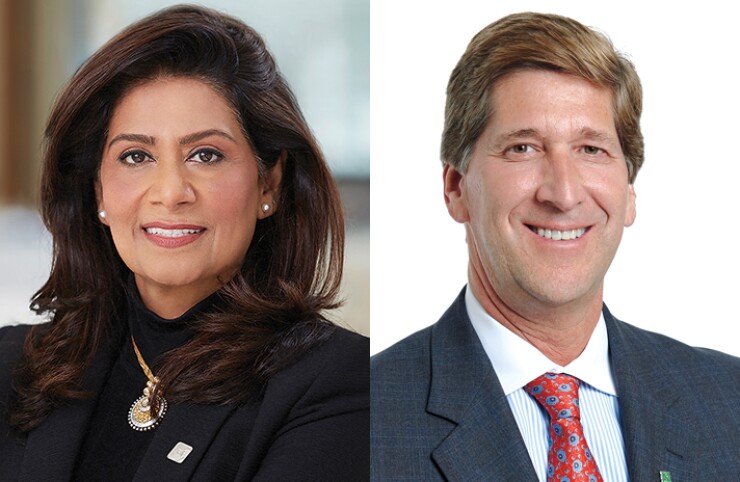Who’s afraid of the Bank of Amazon? Not Citizens Financial Group CEO Bruce Van Saun.
In just the last month, various news outlets have reported that the retail giant Amazon.com is looking to create a
Yet while Amazon has succeeded in disrupting nearly every area of retail — the bankruptcies of once-iconic brands like Borders Books and Toys R Us can be attributed directly to Amazon’s dominance — Van Saun does not see Amazon’s flirtation with banking as a major threat to his industry.

“I look at them and I say, ‘Where’s their point of entry? Where’s a void they can really attack?’ I still think banks are well entrenched,” Van Saun, who is also the chairman at Citizens, said Tuesday at a Consumer Bankers Association’s conference in Orlando, Fla. “I like banking’s chances to hold them off and be competitive.”
Van Saun made those comments during a wide-ranging panel discussion alongside Bank of the West CEO Nandita Bakhshi. The two chief executives shared their thoughts on issues ranging from the challenges in recruiting talent to the future of the branch to the confidence level of their business customers to Amazon’s banking ambitions.
To be clear, Van Saun acknowledged that he does see Amazon as more of a threat now than he did five years ago, largely because Amazon is more ubiquitous than it was then.
Then again, Citizens hasn’t exactly been resting on its laurels. The $152.3 billion-asset bank has upped its own game over that time, partnering with Apple and various fintech firms to upgrade its suite of products, speed up its loan decision-making and improve the overall customer experience. It is also one of the few banks in the business of refinancing student debt, a key initiative in its effort to win over millennial consumers.
“We’re not sitting back and waiting for someone to come in and eat our lunch,” Van Saun said.
While the industry does
“Hardly anybody wants to get into banking, meaning get a license and be regulated the way we are,” she said. “The real thing we have to balance out is, who is the partner and how do we leverage them for our customers?”
In thinking about products and services, bankers also must balance the needs of older generations, who have more money, with those of younger consumers, whose preferences will inevitably shape banks’ successes and missteps.
Van Saun said that Citizens pursues different segmentation strategies for customers of different generations. Citizens can appeal to millennials with a student loan product or with
Bakhshi said that it’s “absolutely” a mistake to assume that older customers won’t use technology, and that contrary to popular belief, tech-attuned millennials often still want the option to walk into a branch and talk to somebody.
The number of bank branches in the U.S. could eventually dwindle by as much as 15% or 20%, Van Saun said, though both CEOs agreed that branches would certainly have a future role as advice centers. “It still has that comfort factor for a certain sector of the population,” Bakhshi said.
The two executives also discussed how their approaches to attracting talent have shifted. For instance, the Providence, R.I.-based Citizens now relies more heavily on digital channels for recruitment while also partnering with various universities in Rhode Island to source talent.
“Our on-campus recruiting program is well advanced from what it was five or 10 years ago,” Van Saun said. “Part of the strategy now is, you’ve got to start investing in bringing in people.”
Meanwhile, the $89.8 billion-asset Bank of the West, a unit of the French banking giant BNP Paribas, has been able to use its San Francisco base to its advantage. Its proximity to Silicon Valley means the bank is able to attract a mix of talent: people with traditional banking experience and people from the tech world.
“Not every company becomes Google and Apple, so there are certainly individuals who want the job security and might want to try out something they’ve done and bring it to the bank,” Bakhshi said.
The two CEOs said that they expect a busier year ahead for commercial lending. Clients’ outlook improved last year in anticipation of business-friendly policies, but given uncertainty around health care and tax reform, that optimism didn’t show up in commercial clients’ borrowing activities.
Van Saun said that the passage of tax reform late in the year had spurred clients to start thinking more seriously about capital investments and deals. Both CEOs said they expect to see a higher volume of activity from their commercial clients this year.
“There’s definitely a mood of confidence in our customers in the small and medium enterprises and also the medium market and up-market customer,” Bakhshi said. “We’re hoping to see lending go up because coming out of the crisis that took a big hit.”





